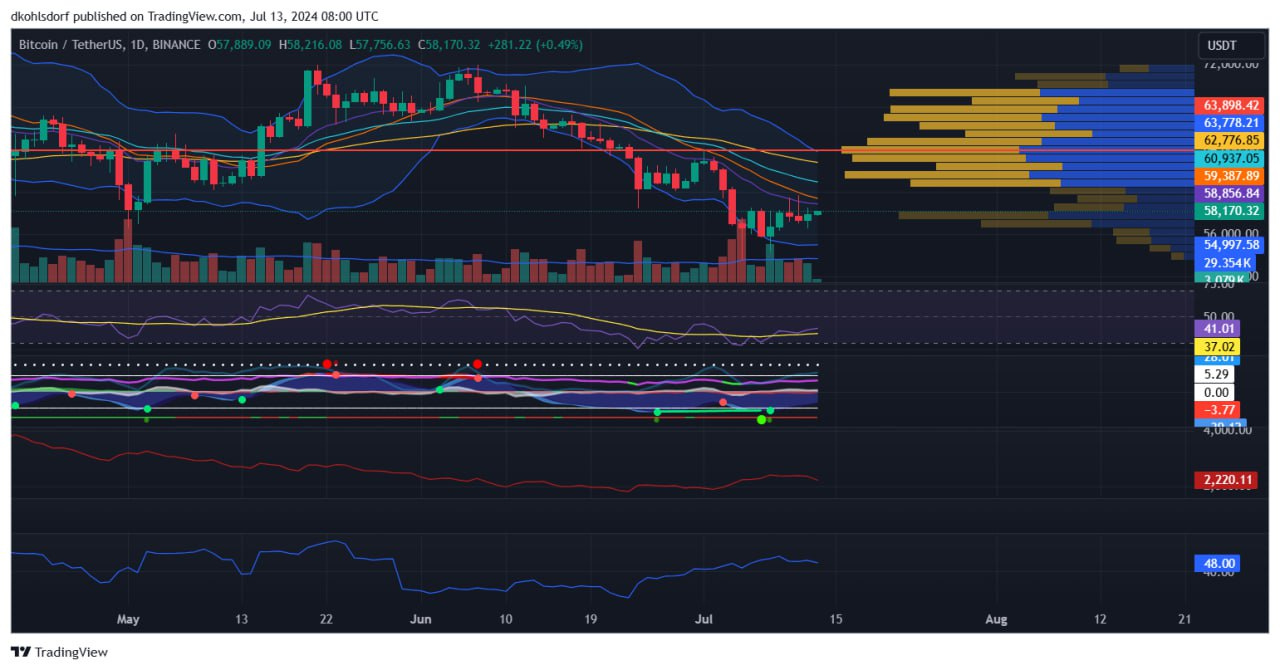To sell or not to sell.
In the latest issue of Compass, we highlighted three main bearish factors influencing Bitcoin's price: miner capitulation, Mt. Gox repayments, and sales by the German government. Collectively, whether through direct Bitcoin sales on exchanges or due to the fear created in the market leading to the sale by short-term holders, the price behaved as anticipated. It recovered the edge of the three-month range limit but failed to surpass its two major resistances: the Daily 200 EMA at $58.3K and the $60K mark.
The macro framework in the cryptocurrency market has once again become a factor contributing to volatility, as marked by the testimony before Congress by U.S. Federal Reserve Chair Jerome Powell and U.S. inflation data released on Thursday. Bitcoin's price responded positively to the favorable inflation figures but retreated due to selling pressure near the $60K barrier. As we can see in our speedometers in Figure 1, the overall market environment is still gloomy with significant risk to the downside.
One of the bearish factors has been removed from the seller's checklist: the German government has completely emptied its Bitcoin wallets. The market cleanup and the transfer of Bitcoin ownership have concluded after three weeks of fear and speculation, leaving behind a clear bearish sentiment. This environment is likely favorable for strong hands to increase their Bitcoin holdings, but the question we pose is: With the completion of sales by the German government, are sellers exhausted, or do they still have the stamina for the next sprint?
The Dove and the Hawk.
U.S. Federal Reserve Chair Jerome Powell testified before Congress for two consecutive days, stating that the data showed modest progress toward the 2% inflation target. He added that more data (specifically, more Consumer Price Index readings closer to this target) are needed to consider interest rate cuts. Powell's testimony was interpreted as a dovish stance by the markets, leading the likelihood of a rate cut in September to jump to a 70% probability (by now 93% probability, see Figure 2).
June's inflation data confirmed a continuing downward trend, increasing the likelihood of a rate cut in September to 90%. The Consumer Price Index (CPI) report showed a year-over-year stabilization at 3.0%, while the Core CPI, which excludes volatile items like food and energy, rose by 0.1% in June, better than the expected 0.2%.
The inflation data prompted Bitcoin to spike close to the $60K zone, a gain that was reversed just hours after the data was released. The anticipation of a potential interest rate cut is a bullish signal for the market. Can we interpret that July and August might be a period of consolidation in anticipation of an interest rate cut catalyzing a bullish final quarter of the year?

Compression, Not Depression.
Bitcoin's price has formed a narrow range between $56.3K and $59.5K over the last few days, creating a compression zone that generally leads to increased volatility as the price breaks out of this compression. We have also noted the formation of a bullish divergence on the Daily timeframe, which, at least theoretically, could break the compression upwards. If we zoom into the four-hour chart, we can see how the price is consolidating within this range.
Now that the selling pressure from the German government has eased, the path is clear for Bitcoin to challenge the resistance levels at $58.3K and $60K. However, the overconfidence of the bulls, especially the leverage on the upside, is a factor to consider before anticipating higher prices. Typically, this scenario involves seeking to liquidate bullish positions with swift downward movements, only to rise more vigorously afterward. A typical pattern in compression zones involves false breakouts, either upward or downward, aimed at triggering liquidations and subsequently consolidating the definitive movement.
Nevertheless, we cannot yet celebrate. The schedule for the Mt. Gox repayments will still take place during July and August, which in itself represents a selling threat, not only by its very nature but also due to the Fear, Uncertainty, and Doubt (FUD) it causes among investors. We have undertaken the task of investigating how these much-anticipated (and feared) movements have been scheduled. We will share our findings with you this coming Wednesday to give you a more informed perspective.
Key Takeaways.
There are three main bearish influences on Bitcoin's price: miner capitulation, Mt. Gox repayments, and sales by the German government. One of the bearish factors was removed as the German government emptied its Bitcoin wallets, which could reduce the selling pressure on Bitcoin.
Bitcoin's price briefly recovered but could not surpass major resistance levels at the Daily 200 EMA ($58.3K) and the $60K mark. Some positive movements have occurred, but significant barriers to upward price momentum remain.
Powell’s recent testimony, perceived as dovish, along with favorable inflation data, has influenced market expectations, increasing the likelihood of a rate cut by the Fed in September, which is seen as a bullish sign for Bitcoin.
Bitcoin has been trading in a narrow range, creating a compression zone that might lead to a significant price movement once it breaks out.
Despite the potential easing of some bearish pressures, there are ongoing concerns, particularly with the upcoming Mt. Gox repayments scheduled for July and August.







Looking forward to the Wednesday piece